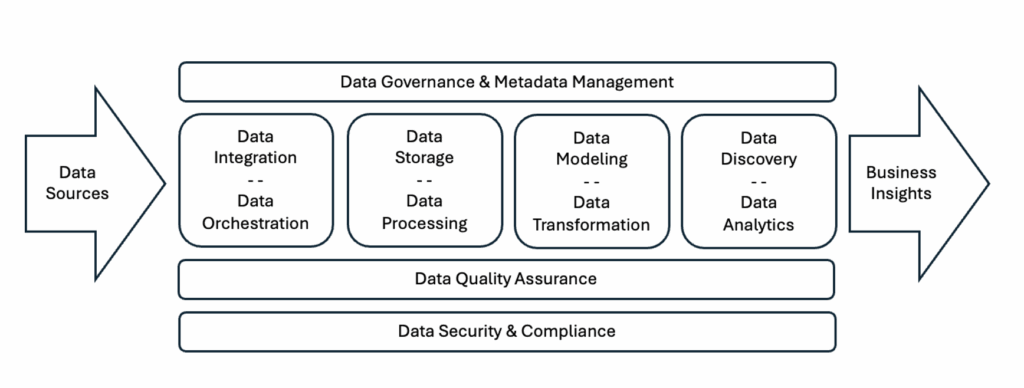
Modern telecommunications networks are undergoing an extensive transformation, driven by the explosive growth and potential of AI, 5G, and IoT applications. These technologies are more than just industry buzzwords; they are fundamentally reshaping how telecom operators manage, process, and extract value from their data assets, including network data, call-detail records, customer demographics and preferences, and data from CRM and BSS/OSS systems. These data assets are vital for optimizing network performance, gaining a deeper understanding of customers, and creating innovative, personalized products and services that boost customer satisfaction. Data also underpins critical business support, operational support, and network management functions.
At the heart of this transformation is the pressing need for a data framework that is robust, scalable, high-performance, flexible, and extensible, capable of meeting the relentless demands of real-time processing and ever-increasing data volumes. Data has become the central focus as we stand on the threshold of an “AI-first” era. Much like the “cloud-native” and “mobile-first” approaches that shaped the past decade, the telecom sector must now embrace a “data-first” modernization strategy to fully leverage emerging AI, 5G, and IoT technologies. Companies that delay this transition risk diminished competitive advantage, stunted revenue growth, reduced market relevance, and a lack of the agility required to respond to evolving customer expectations and industry disruptions.

Telecom data frameworks have undergone an astounding transformation over the past three decades, evolving alongside the industry’s expanding data needs. The journey began with basic on-premises data warehouses in the 1990s, primarily serving rudimentary billing and operational systems through structured data and fixed schemas. As mobile networks proliferated in the 2000s, these systems expanded to incorporate more diverse data sources but remained fundamentally siloed. The 2010s marked a paradigm shift with the emergence of big data technologies and cloud computing, enabling telecom operators to implement data lakes capable of storing vast amounts of unstructured network, customer, and application data. However, these early implementations often lacked governance and efficient processing capabilities. The current era represents the most sophisticated stage yet, with telecom providers embracing data lakehouses that combine the flexible storage of data lakes with the robust governance and performance of warehouses. These modern frameworks support real-time processing essential for 5G networks, incorporate AI/ML capabilities for predictive operations, and maintain strict compliance with evolving data privacy regulations. Looking forward, telecom data frameworks are evolving toward fully distributed architectures with edge computing components that process data closer to its source, enabling ultra-low latency 5G applications while maintaining centralized governance through comprehensive data meshes and fabrics that unify the entire data ecosystem. However, note that this advanced architecture also introduces new complexities. Managing data consistency and synchronization across a geographically dispersed network of edge nodes presents significant challenges, as does ensuring robust security and compliance for data processed and stored outside centralized data centers. Overcoming these hurdles will be critical for realizing the full potential of edge-enabled 5G applications.
The vendor ecosystem has followed a similar trajectory. Over the past two decades, our corporate journey reveals a remarkable evolution in our solutions. What began as “software-driven” systems — deliberately designed to treat all subscribers in a uniform, generic manner and generate/store minimal data for basic reporting — has transformed into “data-abundant” platforms. These modern solutions leverage rich data streams with precisely calibrated software to deliver highly personalized services. Today, our solutions deliver deep insights into daily operations through a flexible suite of analytics, reporting, and troubleshooting tools, empowering us to tailor experiences and drive smarter decision-making. Furthermore, we are no longer restricted to on-premises deployments as we have an ever-increasing footprint of cloud-based deployments.
Modern data frameworks are dynamic ecosystems designed to handle vast and varied data flows, enabling real-time processing, advanced analytics, and seamless integration. By transforming raw data into actionable insights, these frameworks help telecoms optimize operations, enhance customer experience, and drive business growth.

A robust modern data framework in telecom features the following pillars:
- Data Integration & Orchestration: This component orchestrates the flow of data ingested from various data sources, integrating and unifying diverse formats and types into the framework.
- Data Storage & Processing: This central component is where all data resides. It encompasses the technologies and infrastructure required for efficient data storage and the execution of essential processing activities.
- Data Modeling & Transformation: Working in conjunction with storage and processing, this component structures, cleans, transforms data into formats suitable for analysis.
- Data Discovery & Analytics: This component utilizes the processed data to generate insights through BI, reporting, and advanced analytics, including AI/ML. These insights ultimately drive business value.
In addition to these pillars, a modern data framework includes the following horizontal layers, which support and interact with every stage of data flow across the pillars:
- Data Governance & Metadata Management: This layer defines how data is managed, accessed, and used, and tracks key information such as definitions, origins, and usage. Comprehensive data lineage ensures transparency and accountability by tracing data from source to consumption.
- Data Quality Assurance: This layer ensures data remains accurate, consistent, and reliable throughout its lifecycle, supporting trustworthy business decisions. Modern tools add real-time observability to quickly detect and address data issues before they impact operations.
- Data Security & Compliance: This layer ensures that all data is safeguarded against unauthorized access and breaches while also confirming that the organization adheres to all legal and regulatory obligations. This encompasses various measures, from encryption and access controls to privacy policies and audit trails.
The figure below illustrates the conceptual architecture of pillars vs horizontal layers.

From an implementation perspective, modern data frameworks are designed to be deployable both on cloud platforms and on-premises environments. While cloud-based solutions may offer agility, cost-efficiency, and elastic scalability, on-premises deployments provide greater control over sensitive data and compliance. Many telecom operators are likely to adopt hybrid or even multi-cloud strategies to balance these benefits effectively.
Telecom operators have several implementation options for their data frameworks:
- Commercial Software/Platforms: Pros of this approach include faster setup, dedicated support, and out-of-the-box features. Cons include potential vendor lock-in, licensing costs, and limited customization.
- Managed Services: Pros of this approach include accelerated time-to-value, reduced operational overhead, and scalability. Cons include potential vendor lock-in, operational costs, less infrastructure control.
- Open-Source Technologies: Pros include future-proof investment (due to no vendor lock-in), cost-effectiveness, and high flexibility. Cons include significant expertise to build and maintain such a framework.
This diversity allows telecom operators to tailor their data framework to their unique business and technology requirements.
In today’s telecom landscape, the ability to quickly analyze massive data sets is crucial. Modern frameworks — built on discoverability, observability, and governance — empower operators to drive operational excellence, support AI/ML initiatives, and make smarter business decisions, from real-time anomaly detection to personalized customer offers. Imagine a telecom operator aiming to boost customer loyalty and revenue through personalized offers. With a modern data framework, they can unify data like customer demographics, usage patterns, subscriptions, and support interactions. AI/ML-powered analytics can then identify individual needs and trigger timely actions. For example, if a customer is close to their data cap, the system can automatically offer a data boost or plan upgrade. Similarly, AI/ML can analyze a customer’s subscriptions and charging history to time balance recharge attempts for when they are most likely to succeed. This data-driven personalization not only enhances customer satisfaction but also creates new business opportunities by proactively matching services to user needs.
The future of telecom is undeniably data-driven. Investing in the right data framework today will not only shape tomorrow’s industry leaders but also unlock new opportunities for innovation, efficiency, and customer engagement. Now is the time to adopt a data-first modernization strategy — empowering your organization to turn raw data into a strategic asset and secure your place at the forefront of the 5G and AI era.



